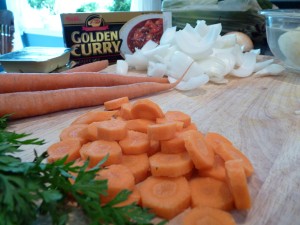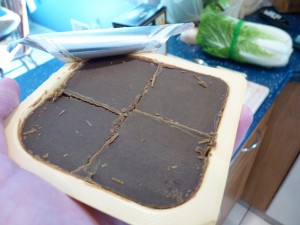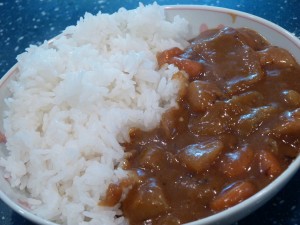Well, well, well. Someone’s been very naughty and neglectful of his blog, and I’m only feeling mildly apologetic. Still (much like every other time), I promise to be more passionate about updates from now on. Really.
Let’s talk about “curry rice,” a Japanese (really!) take on a food quite different from traditional Japanese cuisine. Curry rice (カレーライス) is the quintessential Japanese comfort food, a plate of white rice and a curry sauce with meat and veggies. This no doubt sounds surprising to those less familiar with Japan (I can hear some of your hearts screaming, “Isn’t it sushi!?”).
The truth of the matter is that curries are comfort food for the English, as well, due to the fact that England once made India its bitch. When the English opened trade with Japan, they brought with them their take on curry, which proved to be immensely popular. Over the years, curry rice became such a staple of the Japanese family meal because of its flavor, ease, and cost-effective prep, that you could bank on eating at least once a week. Think of it in the way same way the American family (or at least mine did) grows up with spaghetti and meatballs once a week, with jarred sauce, and you’ll understand Japan’s similar bastardization (and fondness) of curry.
Curry is made from a roux, which, in Japan, comes boxed and pre-made in the grocery store; recently, it’s in many American supermarkets, as well. Heat levels vary from mild to extra-freaking-hot, and those levels change between brand, so one company’s ‘medium’ might actually be more or less hot than another’s. The various roux all have differences in taste as well, although some are quite subtle, so it’s all about finding a brand you like and sticking with it. The basic things you add to the sauce are pork (or beef), carrots, potatoes, and onions.

Now, moving back to the spaghetti and meatballs example, a lot of Americans (at least growing up, this was my experience) don’t mess around with jarred sauce — they plop it out, heat it up, and plop it on pasta. This isn’t the case with curries in Japan; even if you use a boxed roux, you screw with it. You get in its grill and rearrange its face. By the time you’re ladling it onto your plate, you’ve given the flat-chested curry a pair of buoyant double-Ds.
Following is my basic prep for curry, but in the summer I like to vary up the ingredients by swapping in veggies like eggplant and tomato, and I enjoy chicken just as much as I do pork.
Bao’s Curry Rice
Serves 4-6.
8.2 oz/120 g curry sauce roux, any heat level (half of the big box, or all the smaller boxes)
1 lb boneless, skinless chicken thighs, trimmed of excess fat and cut into bite-sized pieces
1 large carrot or 2 small, peeled and cut into 1/4″ disks
2 medium onions, sliced
1 small red chili, or a generous pinch red pepper flakes (optional)
1 clove garlic, minced
1, 1″ knob ginger, minced
2 medium potatoes, peeled and cut into bite-sized chunks
27 oz/800 ml chicken stock or water
1 bay leaf
2 tbsp ketchup
2 tsp Worcestershire sauce
Semi-sweet or unsweetened chocolate (optional)
Honey (optional)
1 tbsp grated apple (optional)
Vegetable oil
3 cups steamed white rice, for serving
Heat the oil in a medium pot over medium-high heat. Add the chicken and stir-fry until it begins to brown; remove to a paper towel-lined plate. Add more oil if necessary, then add onions, carrots, and chili if using. Stir-fry until the vegetables soften and start to brown, about 5 minutes. Add garlic and ginger and stir-fry for one minute.
Return the chicken to the pot and add the stock, potatoes, and bay leaf. Bring to a boil, and then reduce heat and simmer until potatoes are tender, about 20 minutes, taking care to skim any fat off the surface of the water. When the potatoes are tender, remove the pot from the heat, break up the packaged roux, and add it to the pot. Stir carefully off the heat until the roux has completely dissolved and you have a curry sauce, about 2 minutes. Stir in ketchup and Worcestershire.

Return the pot to low heat, letting it simmer gently and stirring occasionally (do not let the bottom burn). After ten minutes, the sauce should have thickened up nicely. Taste! If you like it, brilliant, but this is the part where I adjust. I like a touch of sweetness in my curry (the boxes can be very one-dimensional), so I will add grated apple and a spoonful of honey to taste. Chocolate adds amazing depth if you have it, but make sure you taste the chocolate for sweetness before adding a little bit at a time.
After adjusting the flavors to taste, let simmer for five more minutes, then plate up! Scoop enough rice to take up half of the curry plate, then pool the curry in the other half. Eat with spoon and enjoy.

You’ll probably have leftovers (I usually do), and as I discovered, reheating the curry in its pot, adding milk to curry in a ratio of 3:1 and simmering for a few minutes creates a beautiful curry chowder. Toss in some blanched broccoli and you’ve got a delicious and warming meal.
